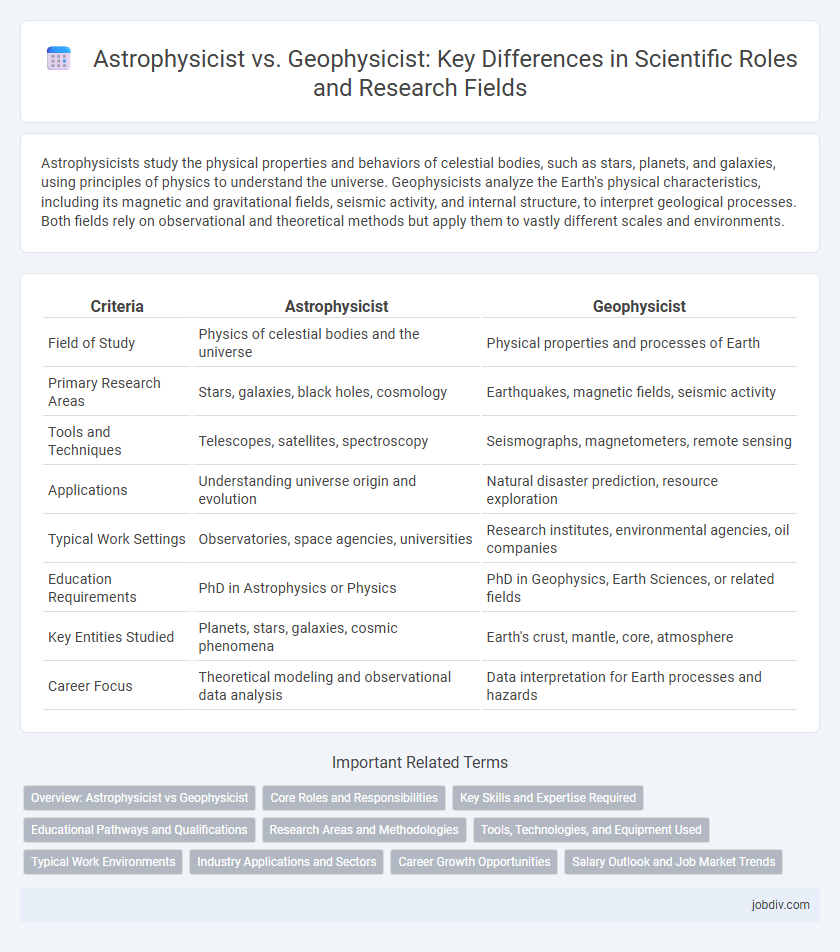Astrophysicists study the physical properties and behaviors of celestial bodies, such as stars, planets, and galaxies, using principles of physics to understand the universe. Geophysicists analyze the Earth's physical characteristics, including its magnetic and gravitational fields, seismic activity, and internal structure, to interpret geological processes. Both fields rely on observational and theoretical methods but apply them to vastly different scales and environments.
Table of Comparison
| Criteria | Astrophysicist | Geophysicist |
|---|---|---|
| Field of Study | Physics of celestial bodies and the universe | Physical properties and processes of Earth |
| Primary Research Areas | Stars, galaxies, black holes, cosmology | Earthquakes, magnetic fields, seismic activity |
| Tools and Techniques | Telescopes, satellites, spectroscopy | Seismographs, magnetometers, remote sensing |
| Applications | Understanding universe origin and evolution | Natural disaster prediction, resource exploration |
| Typical Work Settings | Observatories, space agencies, universities | Research institutes, environmental agencies, oil companies |
| Education Requirements | PhD in Astrophysics or Physics | PhD in Geophysics, Earth Sciences, or related fields |
| Key Entities Studied | Planets, stars, galaxies, cosmic phenomena | Earth's crust, mantle, core, atmosphere |
| Career Focus | Theoretical modeling and observational data analysis | Data interpretation for Earth processes and hazards |
Overview: Astrophysicist vs Geophysicist
Astrophysicists study celestial phenomena, focusing on the physics of stars, galaxies, and the universe's origin using observational data and theoretical models. Geophysicists examine Earth's physical properties, including seismic activity, magnetic fields, and internal structure, employing techniques like seismology and geodesy. Both fields rely heavily on physics principles but apply them to vastly different scales and environments, with astrophysicists exploring space and geophysicists analyzing terrestrial processes.
Core Roles and Responsibilities
Astrophysicists investigate the physics of celestial bodies and the universe, analyzing cosmic phenomena such as black holes, neutron stars, and dark matter using advanced telescopes and mathematical models. Geophysicists study Earth's physical properties, including seismic activity, magnetic fields, and gravitational forces, to understand natural processes like earthquakes and the planet's internal structure. Both fields employ quantitative data and experimental methods but diverge in focus: astrophysics explores extraterrestrial objects and cosmic events, while geophysics concentrates on terrestrial processes and Earth's dynamics.
Key Skills and Expertise Required
Astrophysicists require advanced skills in mathematical modeling, data analysis, and expertise in physics, particularly in areas such as cosmology, stellar dynamics, and quantum mechanics. Geophysicists need proficiency in seismic interpretation, geospatial analysis, and knowledge of Earth's physical properties, including magnetism, gravity, and plate tectonics. Both professions demand strong problem-solving abilities and expertise in using specialized software for simulation and data visualization.
Educational Pathways and Qualifications
Astrophysicists typically pursue a bachelor's degree in physics or astronomy, followed by a Ph.D. specializing in astrophysics or related fields such as cosmology or planetary science. Geophysicists generally obtain a bachelor's degree in geophysics, geology, or earth science, advancing to a master's or doctoral degree focusing on sub-disciplines like seismology, volcanology, or environmental geophysics. Both career paths emphasize strong foundations in mathematics, physics, and computer modeling, but astrophysics leans heavily toward theoretical and observational techniques, while geophysics integrates fieldwork and applied earth system analysis.
Research Areas and Methodologies
Astrophysicists primarily investigate celestial phenomena such as black holes, stars, and cosmic microwave background radiation using telescopes, spectral analysis, and computational simulations. Geophysicists focus on Earth's physical properties, including seismic activity, magnetic fields, and atmospheric processes, employing methods like seismic wave analysis, remote sensing, and geodetic measurements. Both disciplines utilize advanced modeling techniques but apply them to vastly different domains--astrophysics to understand universal laws beyond Earth and geophysics to analyze Earth's internal and surface dynamics.
Tools, Technologies, and Equipment Used
Astrophysicists utilize advanced telescopes, spectrometers, and space probes to analyze celestial phenomena and gather data from distant galaxies. Geophysicists employ seismographs, magnetometers, and ground-penetrating radar to study Earth's physical properties and subsurface structures. Both fields leverage computational modeling software for data simulation and interpretation to enhance scientific understanding.
Typical Work Environments
Astrophysicists typically work in observatories, research universities, and space agencies, where they analyze celestial phenomena using telescopes and computational models. Geophysicists conduct their research in field sites, laboratories, and government agencies, studying Earth's physical properties through seismic surveys and remote sensing technology. Both professions often collaborate with interdisciplinary teams but differ significantly in their primary research environments and tools.
Industry Applications and Sectors
Astrophysicists primarily contribute to aerospace, space exploration, and satellite technology industries by analyzing cosmic phenomena and developing models of celestial mechanics. Geophysicists find applications in natural resource exploration, environmental monitoring, and earthquake hazard assessment, leveraging seismic data and geophysical surveys to inform mining, oil extraction, and infrastructure projects. Both disciplines intersect with government research agencies, defense sectors, and academia, driving innovation in Earth and space sciences.
Career Growth Opportunities
Astrophysicists primarily explore cosmic phenomena, with career growth often linked to research institutions, academia, and space agencies such as NASA or ESA, offering roles in theoretical modeling and observational astronomy. Geophysicists focus on Earth's physical properties, finding diverse opportunities in environmental consulting, oil and gas exploration, and government agencies like the USGS or NOAA, where applied skills in seismic analysis and geospatial technology are highly valued. Both fields promise continuous advancement through specialization and interdisciplinary collaboration, but market demand and funding availability significantly influence career trajectories.
Salary Outlook and Job Market Trends
Astrophysicists typically earn an average salary of $115,000 per year, with job growth projected at 5% over the next decade due to advancements in space exploration and research funding. Geophysicists command a median annual salary of approximately $95,000, driven by demand in environmental consulting, oil and gas industries, and natural resource management, with a steady job market growth rate near 4%. Both fields offer specialized career opportunities, but astrophysics trends favor academic and governmental research, while geophysics is closely tied to applied industrial sectors.
Astrophysicist vs Geophysicist Infographic

 jobdiv.com
jobdiv.com